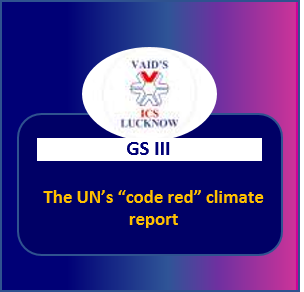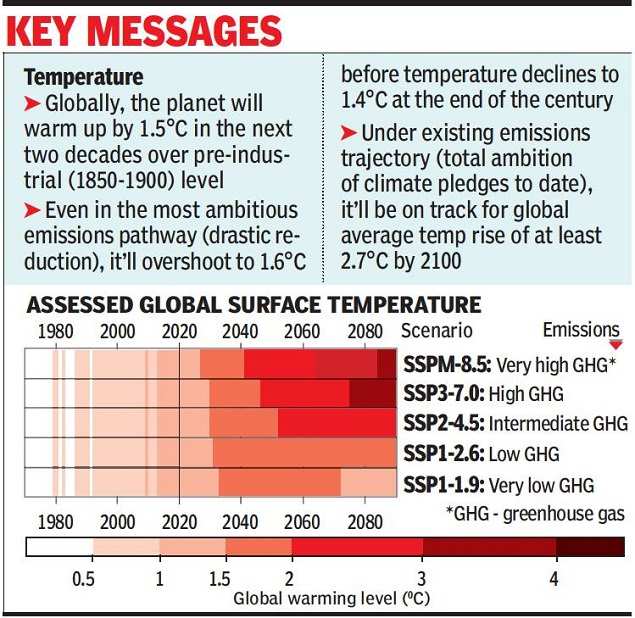CURRENT AFFAIRS
Get the most updated and recent current affair content on Padhaikaro.com
The UN’s “code red” climate report
- Vaid's ICS, Lucknow
- 21, Aug 2021

Why in News?
The IPCC has issued arguably its strongest warning yet on impending catastrophe from unmitigated global warming caused by human activity, lending scientific credence to the argument that rising wildfires, heatwaves, extreme rainfall and floods witnessed in recent times are all strongly influenced by a changing climate.
The Intergovernmental Panel on Climate Change (IPCC) has released its Sixth Assessment Report, titled “Climate Change 2021: The Physical Science Basis”.
IPCC reports on Climate Change:
- The IPCC produces reports that contribute to the work of the UN Framework Convention on Climate Change (UNFCCC), the main international treaty on climate change.
- IPCC reports cover the scientific, technical and socioeconomic information relevant to understanding the scientific basis of risk of human-induced climate change, its potential impacts and options for adaptation and mitigation.
- The objective of the UNFCCC is to “stabilize greenhouse gas concentrations in the atmosphere at a level that would prevent dangerous anthropogenic (human-induced) interference with the climate system.”
- The IPCC does not carry out original research, nor does it monitor climate or related phenomena itself.
- Rather, it assesses published literature, including peer-reviewed and non-peer-reviewed sources. However, the IPCC can be said to stimulate research in climate science.

IPCC Report: “Climate Change 2021: The Physical Science Basis”:
- The report states that human activities are causing climate change, and the planet is irrevocably headed towards warming by 1.5 degrees Celsius over pre-industrial times in the next two decades.
- The report predicts that based on existing commitments by countries to curb their emission, the world is on track for global temperature warming by at least 2.7°C by 2100, calling it ‘Code red for humanity’.
- The report also mentions that unless extremely deep emission cuts are undertaken by all countries immediately, the 2015 Paris Agreement goals are unlikely to be met.
- In a stark report on the physical science basis of climate change contributed for a broader Assessment Report of the UN, the IPCC’s Working Group I have called for deep cuts to carbon dioxide emissions and other greenhouse gases and a move to net zero emissions, as the world would otherwise exceed 1.5°C and 2°C of warming during the 21st century with permanent consequences.
Consequences of warming of 21st century:
- The new report attributes catastrophic events to sustained global warming, particularly the frequency and intensity of hot extremes, marine heatwaves, heavy precipitation, agricultural and ecological droughts, proportion of intense tropical cyclones, reductions in Arctic Sea ice, snow cover and permafrost.
- A phenomenon such as heavy rainfall over land, for instance, could be 10.5% wetter in a world warmer by 1.5°C, and occur 1.5 times more often, compared to the 1850-1900 period.
- More than five years after the Paris Agreement was concluded, there is no consensus on raising ambition to reduce emissions, making access to low carbon technologies easier, and adequately funding mitigation and adaptation.
- COVID-19 had the unexpected effect of marginally and temporarily depressing emissions.
- The IPCC’s analysis presents scenarios of large-scale collapse of climate systems that future leaders would find virtually impossible to manage.
- Heatwaves and heavy rainfall events experienced with increasing frequency and intensity are just two of these, while disruptions to the global water cycle pose a more unpredictable threat.
- Also, if emissions continue to rise, oceans and land, two important sinks and the latter a key part of India’s climate action plan, would be greatly weakened in their ability to absorb atmospheric carbon dioxide.
Therefore, the report also recommended that countries should strive to achieve net-zero emissions, no additional greenhouse gases are emitted by 2050.
IPCC’s Sixth Assessment Report on India:
- India’s geography makes it extra vulnerable to extreme climate events. The geography of India is such that it is surrounded by the warm tropical waters of the Indian Ocean on all three sides and the melting Himalayas on the north.
- With a 7,517-km coastline, India will also witness a rise in sea levels, leading to frequent and severe coastal flooding in low-level areas.
- Across the six Indian port cities of Chennai, Kochi, Kolkata, Mumbai, Surat, and Visakhapatnam, 28.6 million people would be exposed to coastal flooding if sea levels rise by 50 cm.
- Glaciers in the Hindu Kush Himalayan (HKH) region will keep shrinking and the snow cover will retreat to higher altitudes.
- Changes in monsoon precipitation are expected, with both annual and summer monsoon precipitation projected to increase. More severe rain is expected over southern India in the coming decades.
- The report says the presence of aerosols and particulate matter due to human activity has influenced rainfall events in the Indian subcontinent.
Thus, time has come and denial isn’t saving anyone, anymore. The report calls for renewed demands for all countries to update their climate action plans, termed as nationally-determined contributions or NDCs under Paris Climate Agreement.
Facts for Prelims:
SonChiraiya:
- The ‘SonChiraiya’ brand and logo was launched by the Ministry of Housing and Urban Affairs for marketing urban Self-Help Group (SHG) products.
- This initiative will prove as a step in the right direction towards increased visibility and global access for the products made by urban SHG women.
Blue Berets or Blue Helmets
UN peacekeepers (often referred to as Blue Berets or Blue Helmets because of their light blue berets or helmets) can include soldiers, police officers, and civilian personnel. Peacekeeping forces are contributed by member states on a voluntary basis. Civilian staff of peace operations are international civil servants, recruited and deployed by the UN Secretariat.
Features:
- United Nations Peacekeeping helps countries torn by conflict create conditions for lasting peace.
- Peacekeeping has unique strengths, including legitimacy, burden sharing, and an ability to deploy and sustain troops and police from around the globe, integrating them with civilian peacekeepers to advance multidimensional mandates.